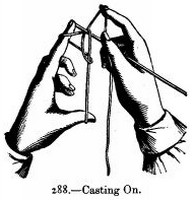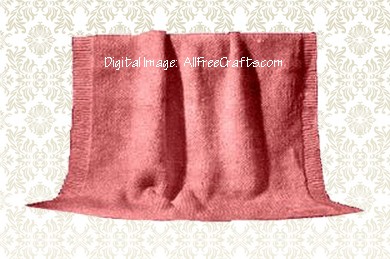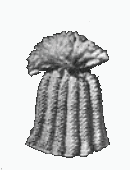Last updated on March 2nd, 2016 at 08:10 pm
 Free Knitting Instructions: Learning How to Knit
Free Knitting Instructions: Learning How to Knit
Free vintage knitting instructions from Beeton’s Book of Needlework 1870, with step by step illustrations for casting on, plain knitting, purl stitches, increasing, decreasing, and casting off.
287.–KNITTING, though considered to be an old-fashioned art, is by no means so ancient as lacemaking. Knitting has never entirely quitted the hands of English and German ladies; indeed, among all good housewives of any civilised country, it is reckoned an indispensable accomplishment. Knitting schools have been established of late years both in Ireland and Scotland, and Her Majesty the Queen has herself set an example of this industry, as well as largely patronised the industrial knitters of Scotland. Of the rudiments of this useful art many ladies are at present ignorant; it is in the hope of being useful to these that the following instructions are offered.
To knit, two, three, four, or five needles, and either thread, cotton, silk, or wool are required.
Knitting needles are made of steel, of ivory, or of wood; the size to be used depends entirely upon the material employed, whether thread, cotton, silk, single or double wool, for knitting. As the size of the needles depends upon that of the cotton, a knitting gauge is used (see No. 287). The gauge (page 290) is the exact size of Messrs. H. Walker and Co.’s knitting gauge. Our readers will remark that English and foreign gauges differ very essentially; the finest size of German needles, for example, is No. 1, which is the size of the coarsest English wooden or ivory needle. Straight knitting is usually done with two needles only for round knitting for socks, stockings, &c., three, four, and five needles are employed.
 288.–Casting On.
288.–Casting On.
This term is used for placing the first row or round of knitting stitches on the needles–“casting them on”–and is done in two ways–by “knitting on” the stitches, or as follows:–
Hold the thread between the first and second finger of the left hand, throw it over the thumb and first finger so as to form a loop, and pass the needle in the loop; throw the thread lightly round the needle, pass it through the loop, and draw up the thread; this forms the first stitch (see No. 288).
 289.–To Knit On.
289.–To Knit On.
Take the needle on which the stitches are cast in the left hand, and another needle in the right hand–observe the position of the hands (No. 289). Hold the left-hand needle between the thumb and third finger, leaving the first finger free to move the points of the needles. (The wonderful sense of touch in the first or index finger is so delicate, that an experienced knitter can work without ever looking at her fingers, by the help of this touch only–in fact, knitting becomes a purely mechanical labour, and as such is most useful.) Insert the point of the right-hand needle in the loop or stitch formed on the left-hand needle, bring the thread once round, turning the point of the needle in [292] front under the stitch, bringing up the thread thrown over, which in its turn becomes a stitch, and is placed on the left-hand needle.
290.–Simple Knitting (plain).
 Pass the right-hand needle into the 1st stitch of the left-hand needle, at the back throw the thread forward, and with the first finger pass the point of the needle under the stitch in forming a fresh stitch with the thread already thrown over, as in “knitting on,” only, instead of placing the newly-formed stitch on the left-hand needle, leave it on the right-hand needle, and let the stitch drop off the point of the left-hand needle. Continue thus until all the stitches are taken from the left to the right-hand needle, and the row is then complete.
Pass the right-hand needle into the 1st stitch of the left-hand needle, at the back throw the thread forward, and with the first finger pass the point of the needle under the stitch in forming a fresh stitch with the thread already thrown over, as in “knitting on,” only, instead of placing the newly-formed stitch on the left-hand needle, leave it on the right-hand needle, and let the stitch drop off the point of the left-hand needle. Continue thus until all the stitches are taken from the left to the right-hand needle, and the row is then complete.
291.–To Purl, Pearl, or Seam.
Seaming or purling a stitch is done by taking up the stitch in front instead of at the back, throwing the thread over and knitting the stitch as in plain knitting; but before beginning to purl, the thread must be brought in front of the needle, and if a plain stitch follows, the thread is passed back after the purl stitch is made (see No. 291).
 292.–To Increase. Increasing or making a stitch is done by throwing the thread once round the needle and in the next row knitting it as an ordinary stitch.
292.–To Increase. Increasing or making a stitch is done by throwing the thread once round the needle and in the next row knitting it as an ordinary stitch.
293.–To Decrease.
This is done in two ways: firstly, taking up two stitches and knitting them together as one; secondly, by taking up a stitch without knitting it, called slipping, then by knitting the following stitch in the usual way, and then slipping the 1st (unknitted) over the 2nd (knitted) (see No. 293). When it is necessary to decrease two stitches at once, proceed thus:–Slip one, knit two stitches together, then slip the unknitted stitch over the two knitted together.
294.–Round Knitting.
To knit a round four or five needles are used; it is thus that stockings, socks, cuffs, mittens, &c., are made. To knit with four needles, cast on, say, 32 stitches upon one needle, insert a second needle in the last stitch of the first, and cast on 30 stitches; proceed in a similar way with a third needle, but casting on 28 only; when this is done, knit the two extra stitches on the first needle on to the last; this makes 30 stitches upon each needle, and completes the round.
295.–Casting Off.
Knit two stitches, and with the left-hand needle slip the first stitch over the second; continue this to the end of the row. Note.–The last knitted row, before casting off, should be knitted loosely.
296.–To Pick up a Stitch.
This is done by taking up the thread between two stitches and forming a stitch with it.






Leave a Reply